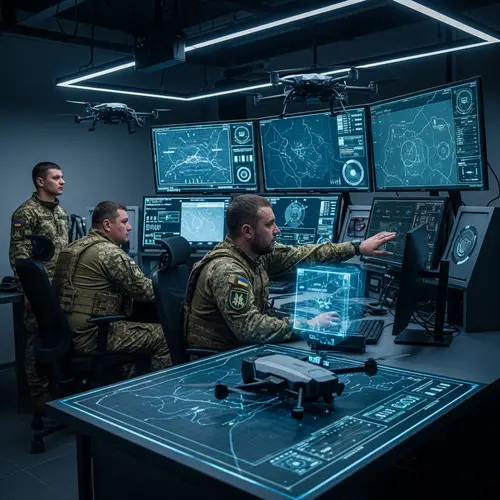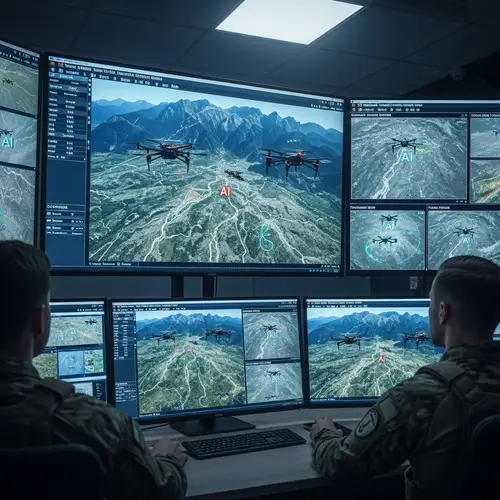Ukraine Partners with Swift Beat to Deploy AI-Powered Combat Drones by 2025

From cyber attacks to the frontlines of warfare, modern battles are increasingly fought with more than boots and bullets. Ukraine is betting big on artificial intelligence by partnering with California-based defense startup Swift Beat to develop combat drones powered by advanced AI algorithms. The move is ambitious, disruptive, and, given the geopolitical stakes—bold to say the least.
What Sparked the AI Combat Drone Initiative?

Since Russia’s full-scale invasion in 2022, Ukraine has actively sought smarter, faster, and more autonomous military technologies. The traditional methods of defense struggle against swarming missiles and relentless drone attacks. Enter AI-powered drones as a plausible answer.
Swift Beat isn’t your average drone manufacturer. Co-founded with backing from former Google CEO Eric Schmidt, the startup is redefining the role of artificial intelligence in real-time warfare. Integrating next-gen sensors, machine learning, and battlefield decision-making, these autonomous instruments are engineered to locate threats and strike with near-zero human input. For Ukraine, it’s not just a tech upgrade—it’s strategic survival.
Ukraine’s Vision: Drones that Think, React, and Strike
Unlike typical UAVs (unmanned aerial vehicles), Ukraine’s upcoming fleet will act with a new level of autonomy. These AI drones are designed to process complex battlefield data—including enemy movements and terrain patterns—on the fly. They don’t just follow commands. They interpret, tactically respond, and even course-correct mid-mission.
According to reports from Kyiv’s Ministry of Strategic Industries, initial Ukraine AI combat drone production plans aim to deliver several hundred units by mid-2025. These aerial systems are tailor-made to intercept Russian drones, disrupt supply lines, and shift air superiority in Ukraine’s favor.
Eric Schmidt’s Role in Accelerating the Program

Eric Schmidt isn’t just a renowned tech executive—he’s become a pivotal figure in defense innovation. His venture capital initiatives have poured resources into firms exploring autonomous systems, cyber resilience, and unmanned security technologies. With Schmidt’s involvement, Swift Beat receives both financial traction and credibility in AI drone technology circles.
More importantly, his influence is helping Ukraine avoid bureaucratic red tape. Instead of dragging through traditional defense procurement cycles, this partnership promotes rapid prototyping and agile deployment. The result? Highly adaptable drones ready for evolving warfront conditions.
What Precisely Sets These Drones Apart from the Swarm?
Let’s break it down. Traditional drones require frequent operator input. They collect data but rely on remote pilots for decision-making. Swift Beat’s AI-powered drones evolve past that limitation.
Here’s what makes them an entirely new kind of instrument on the battlefield:
- Adaptive Threat Recognition: The AI can distinguish between decoys and valid targets.
- Autonomous Navigation: Operates in GPS-jammed environments using computer vision.
- Rapid Response Decisions: Makes microsecond-level judgments during engagements.
- Swarm Coordination: Multiple drones operate as a synchronized group.
- Self-Learning Algorithms: Models evolve with every flight, improving future missions.
By design, these smart drones reduce response time, magnify reconnaissance, and increase offensive agility. That’s not just helpful—it’s game-changing.
AI-Powered Drones Against Russian Threats

Russia has made significant use of Iranian-made drones like the Shahed-136, often deployed in nighttime assaults across Ukrainian urban centers. Ukraine’s response? Meet force with smarter force.
With AI in play, Ukrainian drones can now outmaneuver, outwit, and outstrike their more primitive adversaries. These systems scan for enemy drone launches, track flight patterns, and deliver real-time data to command centers—no operator lag required.
This isn’t science fiction. Successfully integrating AI-powered drones against Russian threats means Ukraine gains the ability to preemptively neutralize attacks before they materialize.
Production Momentum: What’s on the Horizon?

Swift Beat and Ukrainian defense partners are currently conducting field trials in undisclosed locations near the eastern frontlines. These early-stage tests focus on both offensive and reconnaissance roles, with adaptive software receiving real-world data updates.
Ukraine AI combat drone production is scheduled to ramp up via local manufacturing hubs. This decentralization ensures faster response time from prototype to field deployment—plus repair and upgrade logistics right within Ukrainian territory.
By 2025, military officials expect full squadrons of AI drones to complement infantry and conventional air defense platforms.
FAQ: The Future of Autonomous Warfare in Ukraine
They operate with high-level autonomy. While a human operator sets the mission parameters, the drones interpret data, navigate, avoid threats, and select targets without micromanagement.
The systems are built with encrypted communication channels and fail-safes. They’re also able to detect and reroute around suspicious activity in real-time.
Not likely. These AI platforms are force multipliers, not replacements. They handle dangerous or repetitive missions so soldiers can focus on strategic roles.
Ukraine’s Ministry of Defense oversees development in collaboration with Swift Beat. Local manufacturing firms provide components and assembly to maintain sovereignty.
Ensuring consistent AI training in chaotic environments, managing electromagnetic interference, and scaling production under war conditions are major concerns.
Conclusion: A New Age of Defense

Ukraine’s partnership with Swift Beat represents more than just a military upgrade—it signals a paradigm shift. By harnessing AI combat drones for military defense, Kyiv is stepping into a future where intelligence, speed, and autonomy define power.
The question isn’t whether AI drones belong on the battlefield—it’s how many and how soon. And with this alliance, 2025 might just bring an answer.
Curious about AI’s role in future warfare? Bookmark our blog or subscribe to get the latest defense tech updates straight to your inbox.




